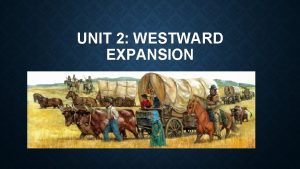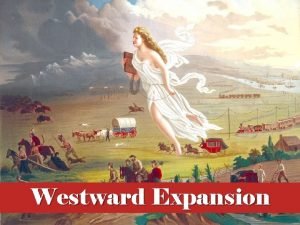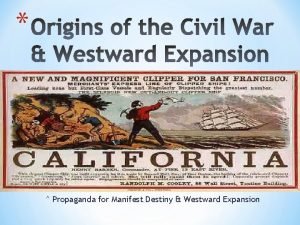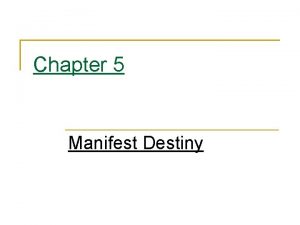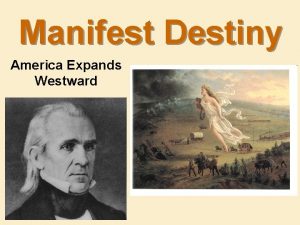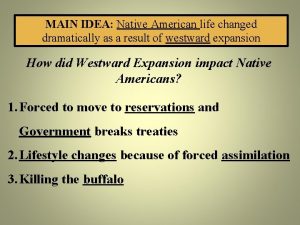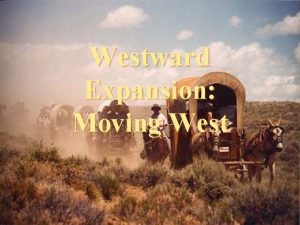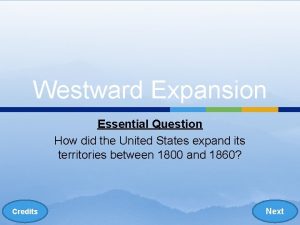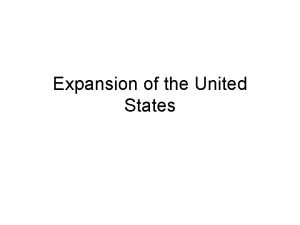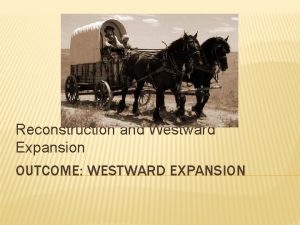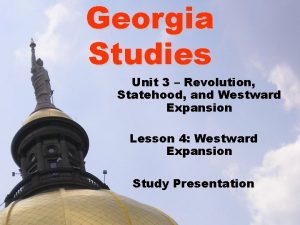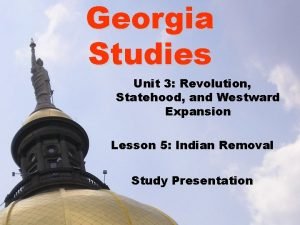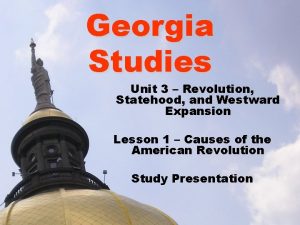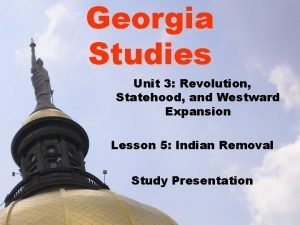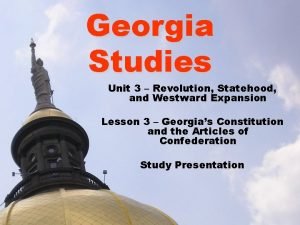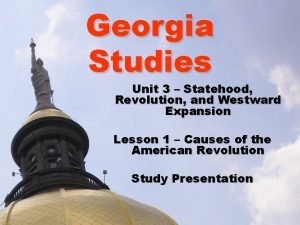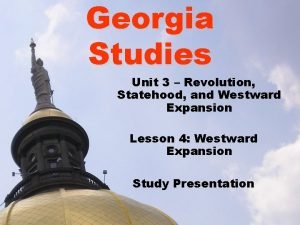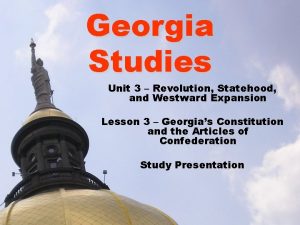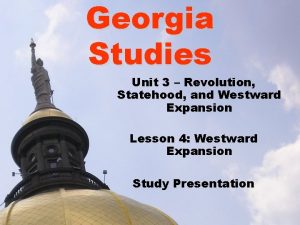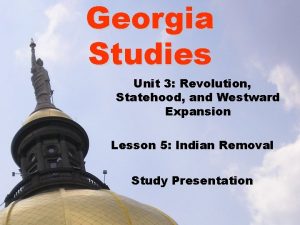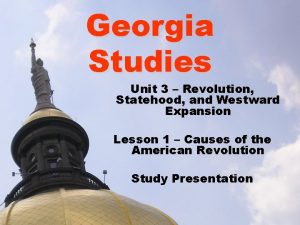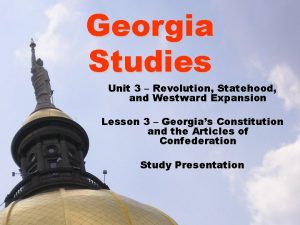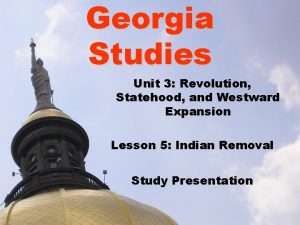Georgia Studies Unit 4 Georgia and the Westward






















- Slides: 22

Georgia Studies Unit 4 – Georgia and the Westward Expansion Lesson 3: Indian Removal from Georgia Study Presentation

Georgia Studies “Unpacking the Standards”: Georgia and the Westward Expansion

Unit 3: Georgia and the Westward Expansion Lesson 3: Indian Removal from Georgia Verbs Nouns

Lesson 3: Indian Removal from Georgia SS 8 H 5 The student will explain significant factors that affected westward expansion in Georgia between 1789 and 1840.

Find the major verbs and nouns and label Lesson 3: them on your “T” Indian Removal Chart. Element d. Describe the role of William Mc. Intosh in the removal of the Creeks from Georgia. Element e. Analyze how key people (John Ross, John Marshall, and Andrew Jackson) and events (Dahlonega Gold Rush and Worcester v. Georgia) led to the removal of the Cherokees from Georgia known as the Trail of Tears.

Unit 3: Georgia and the Westward Expansion Lesson 3: Indian Removal from Georgia Verbs Nouns • Describe • Role in removal of Creeks: 1. William Mc. Intosh • Key people and events that led to the removal of Cherokees: 2. Dahlonega Gold Rush 3. Indian Removal Act 4. John Ross 5. John Marshall 6. Worcester v. Georgia 7. Andrew Jackson 8. Trail of Tears • Analyze

Lesson 3: Indian Removal • Essential Question – How do economic and political factors affect disenfranchised groups? (e. g. Creeks and Cherokees)

Creek Indians • Georgia’s Indian tribes were friendly during the colonial period, but they joined the British in the Revolutionary War. • After the war, Georgians wanted to push American Indians out while they fought to keep their land. • The Creek Nation was prominent in southwestern Georgia and was the most populous tribe in the state.

Creek Indians • Series of clashes between Creek and settlers who pushed into their land known as Oconee War • Treaty of New York: Creek Chief Alexander Mc. Gillivray signed the treaty giving up all land east of the Oconee River, but could keep land on the west side; this angered Georgia settlers, who felt betrayed by their government • Land treaties were often broken • When Georgia gave up the Yazoo Lands to federal government, the U. S. government agreed to remove the Indians still in Georgia.

The Creek War • Red Stick Creeks endorsed war to fight for their land claims; White Stick Creeks wanted peace • Red Sticks attacked Fort Mims, killing more than 400 people • The Battle of Horseshoe Bend, in Alabama, ended the Creek War in 1814; Andrew Jackson led the U. S. troops • The Creeks were forced to give up nearly all their land to the U. S. government • The Treaty of Indian Springs gave up last Creek lands in Georgia to the U. S. ; Chief William Mc. Intosh was later murdered by rival Creeks for signing the treaty

William Mc. Intosh • Scottish father William/ Creek mother Senoya • Wind clan/ Creek chief • Mc. Intosh received a European education in Savannah. • Encouraged Creek Indians to adopt the colonist ways to own property, grow cotton, and own slaves. • Mc. Intosh supported Andrew Jackson in the Creek Indian Wars.

Removal of the Creek • Participated in signing the Treaty of Indian Springs of 1821 which ceded the Creek’s remaining land in Georgia • On February 12, 1825, Chief William Mc. Intosh secretly sold the last of the Creek lands in Georgia to the U. S. government for $200, 000. • Groups of Creek Indians beat, stabbed, & scalped Chief Mc. Intosh for secretly selling away the Creeks’ land to the USA. • By 1827, the Creeks were removed from Georgia and relocated to the wilderness across the Mississippi River.

Removal of the Creeks • Treaty of Washington (1832) resulted in 5 million acres of Creek land ceded to the United States • U. S. agreed to allow Creeks who wished to remain and live on 2 million of those acres; the U. S. promised to protect those who stayed • Those who didn’t wish to stay would have to move to the western territories • The treaty was broken; by 1840, nearly all Creeks were forced to move west

Cherokee Culture • Most advanced of Georgia’s tribes; learned quickly from white settlers • Some, like Chief James Vann, lived in large houses • Chief Vann encouraged Christianity • Sequoyah developed a syllabary, a group of symbols that stand for whole syllables; it gave Cherokees a written form of their language • Government modeled on that of United States; capital at New Echota by 1825 • Lived in northwest Georgia

John Ross • In 1791, the U. S. government signed a treaty guaranteeing that the Cherokee nation could be independent and have its own government. • The Cherokee government was modeled after the U. S. federal government and was led by Chief John Ross. • Son of a Scottish father and a part-Cherokee, part. Scottish mother • Helped create a Cherokee Constitution. • Argued the case for the Cherokee nation before the Supreme Court • Guided the Cherokee through the difficult Trail of Tears march to Oklahoma.

Gold Rush • Gold was discovered on Cherokee lands near Dahlonega, GA in 1829. • The Dahlonega Gold Rush brought thousands of settlers who put more and more pressure on the Cherokee to move.

Indian Removal Act • Andrew Jackson elected president in 1828 • President Andrew Jackson supported Georgia’s interests in removing the Cherokee from their land. • The Indian Removal Act was enacted to remove all Indians from Georgia and settle them on land west of the Mississippi.

Worcester V. Georgia • • The Cherokee nation fought the removal and chief John Ross argued their case before the US Supreme Court. In 1832, Chief Justice John Marshall ruled in favor of the Cherokee in Worcester v. Georgia. The decision declared that the Cherokee Nation was an independent nation and did not need to obey Georgia or US laws. Georgians ignored the ruling and continued to move into Cherokee lands.

Andrew Jackson • • President Andrew Jackson chose to ignore the Supreme Court decision He believed firmly in Indian removal and wanted to get the Cherokee out of Georgia. Worcester v. Georgia should have protected Cherokee lands from white settlement. Because it was not enforced by President Jackson, nothing was done to protect the Cherokee and Georgians continued to settle on Cherokee land.

Cherokee Removal • Indian Removal Act of 1830 – Signed by President Andrew Jackson; made the practice of forcibly removing Native Americans legal. • Dahlonega Gold Rush – Gold was discovered on Cherokee land in north Georgia near the city of Dahlonega; heightened demand for Cherokee land • The Supreme Court of the United States and Chief Justice John Marshall decided that the Cherokee were a sovereign nation and should be allowed to rule themselves (Worcester v. Georgia). • Without the support of Chief John Ross, a rebellious Cherokee group signed a treaty giving away all Cherokee land

The Trail of Tears • Between 1832 and 1835, Cherokees were stripped of their land • In the winter of 1838, thousands of Cherokees were forcibly removed to Oklahoma; about 4, 000 died from disease, exposure, or hunger • 700 to 800 escaped and hid in the North Carolina mountains

https: //www. youtube. com/watch? v=d. I 0 Eqd 3 m. Gd 0&t=2 s
 Unit 3 rev. statehood and westward expansion
Unit 3 rev. statehood and westward expansion Homeland security
Homeland security Unit 2 westward expansion vocabulary
Unit 2 westward expansion vocabulary Paradigm shift from women studies to gender studies
Paradigm shift from women studies to gender studies Westward expansion lewis and clark
Westward expansion lewis and clark Westward expansion virtual field trip
Westward expansion virtual field trip Brain wrinkles
Brain wrinkles How did the hudson river school increase westward expansion
How did the hudson river school increase westward expansion Westward expansion vocabulary words
Westward expansion vocabulary words Gilded age acrostic poem
Gilded age acrostic poem Manifest destiny propaganda
Manifest destiny propaganda Horace greeley letter to r.l sanderson
Horace greeley letter to r.l sanderson Gadsden purchase jimmy fallon
Gadsden purchase jimmy fallon How did westward expansion increase sectional tensions
How did westward expansion increase sectional tensions Westward expansion wagon
Westward expansion wagon Westward expansion vocabulary
Westward expansion vocabulary Effects of westward expansion
Effects of westward expansion Emanuel leutze westward the course of empire
Emanuel leutze westward the course of empire Assimilation westward expansion
Assimilation westward expansion Great plains westward expansion
Great plains westward expansion Westward expansion thesis statement
Westward expansion thesis statement Westward expansion clip art
Westward expansion clip art Westward expansion map
Westward expansion map


